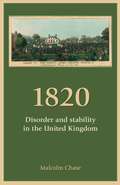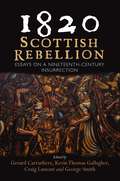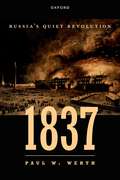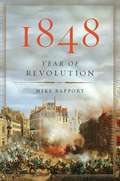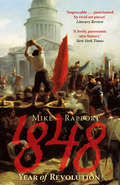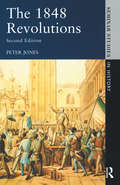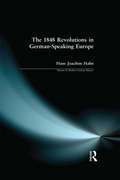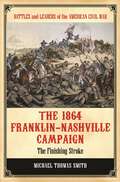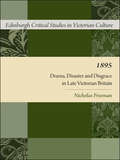- Table View
- List View
1820: Disorder and stability in the United Kingdom (PDF)
by Malcolm ChaseIntegrating in detail the experiences of both Britain and Ireland, 1820 provides a compelling narrative and analysis of the United Kingdom in a year of European revolution. It charts the events and forces that tested the government almost to its limits, and the processes and mechanisms through which order was maintained. This book will be required reading for everyone interested in late-Georgian and early nineteenth-century Britain or Ireland. 1820 is about much more than a single year. Locating the Queen Caroline divorce crisis within a broader analysis of the challenges confronting the government, it places that much-investigated episode in a new light. It illuminates both the pivotal Tory Ministry under Lord Liverpool and the Whigs (by turns febrile and feeble) who opposed it. It is also a major contribution to our understanding of popular radicalism and its political containment.
1820: Disorder and stability in the United Kingdom
by Malcolm ChaseIntegrating in detail the experiences of both Britain and Ireland, 1820 provides a compelling narrative and analysis of the United Kingdom in a year of European revolution. It charts the events and forces that tested the government almost to its limits, and the processes and mechanisms through which order was maintained. This book will be required reading for everyone interested in late-Georgian and early nineteenth-century Britain or Ireland. 1820 is about much more than a single year. Locating the Queen Caroline divorce crisis within a broader analysis of the challenges confronting the government, it places that much-investigated episode in a new light. It illuminates both the pivotal Tory Ministry under Lord Liverpool and the Whigs (by turns febrile and feeble) who opposed it. It is also a major contribution to our understanding of popular radicalism and its political containment.
1820: Essays on a Nineteenth-Century Insurrection
by Gerard Carruthers, Kevin Thomas Gallagher, Craig Lamont and George SmithThe 1820 Scottish Rising has been increasingly studied in recent decades. This collection of essays looks especially at local players on the ground across multiple regional centres in the west of Scotland, as well as the wider political circumstances within government and civil society that provide the rising’s context. It examines insurrectionist preparation by radicals, the progress of the events of 1820, contemporary accounts and legacy memorialisation of 1820, including newspaper and literary testimony, and the monumental ‘afterlife’ of the rising.As well as the famous march of radicals led by John Baird and Andrew Hardie, so often seen as the centre of the 1820 ‘moment’, this volume casts light on other, more neglected insurrectionary activity within the rising and a wide set of cultural circumstances that make 1820 more complex than many would like to believe. 1820: Scottish Rebellion demonstrates that the legacy of 1820 may be approached in numerous ways that cross disciplinary boundaries and cause us to question conventional historical interpretations.
The 1830 Revolution in France
by P. PilbeamThis book explores the nature and scope of the 1830 French revolution. Recent developments in the study of history and in the world have done much to overturn established ideas, both of marxists who believed all revolutions led to socialism, and of liberals who feared violence, but who assumed democracy would triumph. Wedged between the revolutions of 1789 and 1848, the author asks was 1830 a minor bourgeois Parisian event? Although politically avoidable, Dr Pilbeam demonstrates that socially it was part of a long-running struggle of peasants and artisans to preserve their way of life.
1837: Russia's Quiet Revolution
by Paul W. WerthHistorians often think of Russia before the 1860s in terms of conservative stasis, when the "gendarme of Europe" secured order beyond the country's borders and entrenched the autocratic system at home. This book offers a profoundly different vision of Russia under Nicholas I. Drawing on an extensive array of sources, it reveals that many of modern Russia's most distinctive and outstanding features can be traced back to an inconspicuous but exceptional year. Russia became what it did, in no small measure, because of 1837. The catalogue of the year's noteworthy occurrences extends from the realms of culture, religion, and ideas to those of empire, politics, and industry. Exploring these diverse issues and connecting seemingly divergent historical actors, Paul W. Werth reveals that the 1830s in Russia were a period of striking dynamism and consequence, and that 1837 was pivotal for the country's entry into the modern age. From the romantic death of Russia's greatest poet Alexander Pushkin in January to a colossal fire at the Winter Palace in December, Russia experienced much that was astonishing in 1837: the railway and provincial press appeared, Russian opera made its debut, Orthodoxy pushed westward, the first Romanov visited Siberia—and much else besides. The cumulative effect was profound. The country's integration accelerated, and a Russian nation began to emerge, embodied in new institutions and practices, within the larger empire. The result was a quiet revolution, after which Russia would never be the same.
1837: Russia's Quiet Revolution
by Paul W. WerthHistorians often think of Russia before the 1860s in terms of conservative stasis, when the "gendarme of Europe" secured order beyond the country's borders and entrenched the autocratic system at home. This book offers a profoundly different vision of Russia under Nicholas I. Drawing on an extensive array of sources, it reveals that many of modern Russia's most distinctive and outstanding features can be traced back to an inconspicuous but exceptional year. Russia became what it did, in no small measure, because of 1837. The catalogue of the year's noteworthy occurrences extends from the realms of culture, religion, and ideas to those of empire, politics, and industry. Exploring these diverse issues and connecting seemingly divergent historical actors, Paul W. Werth reveals that the 1830s in Russia were a period of striking dynamism and consequence, and that 1837 was pivotal for the country's entry into the modern age. From the romantic death of Russia's greatest poet Alexander Pushkin in January to a colossal fire at the Winter Palace in December, Russia experienced much that was astonishing in 1837: the railway and provincial press appeared, Russian opera made its debut, Orthodoxy pushed westward, the first Romanov visited Siberia—and much else besides. The cumulative effect was profound. The country's integration accelerated, and a Russian nation began to emerge, embodied in new institutions and practices, within the larger empire. The result was a quiet revolution, after which Russia would never be the same.
1847: A Chronicle of Genius, Generosity & Savagery
by Turtle BunburyCapture the spirit of an industrial, social and cultural revolution through this invigorating collection of historical portraits from the dawn of the industrialised world!Though it feels like an era marooned almost irretrievably in the distant past, the 1840s &ndash a decade of blistering social and cultural change – is only two lifetimes removed from the present day. There are, in other words, people alive today who knew and associated with people for whom the Gold Rush and the Great Famine were living memories.Having grown up in an Irish country house built that year, 1847 has long proven the source of inspiration and fascination for historian Turtle Bunbury. And in a bid to once more grasp the spirit of the age, he has over the years assembled an archive of the most remarkable stories from those twelve momentous months.Bristling with all manner of human life and endeavour, from American pioneers and German entrepreneurs to circus charlatans and down-and-out songwriters, 1847 is a collection of his most remarkable discoveries to date and a stirring portrait of a chaotic world surging towards the modern. By turns poignant, outlandish, curious and provocative, this is history at its most invigorating – as panorama, as epic.Praise for The Glorious Madness:‘An absolutely brilliant book.’Patrick Geoghegan, Associate Professor in History at Trinity College, Dublin‘Turtle Bunbury’s open-handed, clear-sighted and finely written book comes fresh and, I might almost say, redeemed out of the moil and storm of controversy that surrounded the topic of the war, in a thousand different guises in the decades since its end. Turtle holds out his hand in the present, seeking the lost hands of the past, in darkness, in darkness, but also suddenly in the clear light of kindness – in the upshot acknowledging their imperilled existence with a brilliant flourish, a veritable banner, of wonderful stories.’Sebastian Barry, author of The Secret Scripture‘Turtle continues the wonderful listening and yarn-spinning he has honed in the Vanishing Ireland series, applying it to veterans of the First World War. The stories he recreates are poignant, whimsical and bleakly funny, bringing back into the light the lives of people who found themselves on the wrong side of history after the struggle for Irish independence. This is my kind of micro-history.’John Grenham, The Irish TimesPraise for Vanishing Ireland:‘A perfect symbiosis between text and images – both similarity affectionate, respectful, humorous, slightly melancholic but never sentimental or nostalgic. This is invaluable social history.’Cara Magazine‘This is a beautiful and remarkably simple book that will melt the hardest of hearts. Bunbury has a light writing style that lets his interviewees, elderly folk from around the country, tell their stories without interference. It’s neither patronising nor overly romantic about the past; just narrating moving tales – The portraits by Fennell are striking, warm and dignified, with a feeling of being invited into people’s lives.’The Sunday Times
1848: Year of Revolution
by Mike RapportA "lively, panoramic" history of a revolutionary year (New York Times) In 1848, a violent storm of revolutions ripped through Europe. The torrent all but swept away the conservative order that had kept peace on the continent since Napoleon's defeat at Waterloo in 1815 -- but which in many countries had also suppressed dreams of national freedom. Political events so dramatic had not been seen in Europe since the French Revolution, and they would not be witnessed again until 1989, with the revolutions in Eastern and Central Europe. In 1848, historian Mike Rapport examines the roots of the ferment and then, with breathtaking pace, chronicles the explosive spread of violence across Europe. A vivid narrative of a complex chain of interconnected revolutions, 1848 tells the exhilarating story of Europe's violent "Spring of Nations" and traces its reverberations to the present day.
1848: Year Of Revolution
by x Mike RapportIn 1848, Europe was engulfed in a firestorm of revolution. The streets of cities from Paris to Bucharest and from Berlin to Palermo were barricaded and flooded by armed insurgents proclaiming political liberties and national freedom. The conservative order which had held sway since the fall of Napoleon in 1815 crumbled beneath the revolutionary assault. This book narrates the breathtaking events which overtook Europe in 1848, tracing brilliantly their course from the exhilaration of the liberal triumph, through the fear of social chaos to the final despair of defeat and disillusionment. The failures of 1848 would scar European history with the contradictions of authoritarianism and revolution until deep into the twentieth century.
1848: The Year of Revolutions (The International Library of Essays on Political History)
by Peter H. WilsonEurope was swept by a wave of revolution in 1848 that had repercussions stretching well beyond the Continent. Governments fell in quick succession or conceded significant reforms, before being rolled back by conservative reaction. Though widely perceived as a failure, the revolution ended the vestiges of feudalism, broadened civil society and strengthened the state prior to the rapid industrialisation and urbanisation of the latter part of the nineteenth century. This volume brings together essays from leading specialists on the international dimension, national experiences, political mobilisation, reaction and legacy.
1848: The Year of Revolutions (The International Library of Essays on Political History)
by Peter H. WilsonEurope was swept by a wave of revolution in 1848 that had repercussions stretching well beyond the Continent. Governments fell in quick succession or conceded significant reforms, before being rolled back by conservative reaction. Though widely perceived as a failure, the revolution ended the vestiges of feudalism, broadened civil society and strengthened the state prior to the rapid industrialisation and urbanisation of the latter part of the nineteenth century. This volume brings together essays from leading specialists on the international dimension, national experiences, political mobilisation, reaction and legacy.
1848 — A European Revolution?: International Ideas and National Memories of 1848
by A. KörnerThis book is among the rare contributions to the 150th anniversary of 1848 which takes a completely new, theoretically informed approach. Instead of a traditional social or political history, the authors analyse the dichotomy between the international dimension in the ideas of the revolution and the nationalisation of memories in its commemorations over the past 150 years. The book offers original research on the history of European ideas and takes part in the current debate about the relationship between history and memory.
1848. Akteure und Schauplätze der Berliner Revolution (Reihe revolution revisited #1)
by Rüdiger Hachtmann Susanne Kitchun Rejane HerwigAls einzige Revolution des 19. und 20. Jahrhunderts besaß die Revolution von 1848/49 eine gesamteuropäische Dimension. Sie erfasste zahllose Menschen und kannte viele Bühnen, an allen europäischen Brennpunkten des Jahres 1848. Dieses Buch setzt Schlaglichter, exemplarisch für die preußische Hauptstadt, die neben Paris und Wien von März bis November 1848 die europäische Revolutionsmetropole war. Manfred Gailus wendet sich der wichtigsten sozialen Trägergruppe der städtischen Revolutionsbewegung zu, den sozialen Unterschichten, und stellt deren typische Politik- und Protestformen vor. Rüdiger Hachtmann zeigt, dass die Revolution von 1848 auch ausgeprägte Züge einer Jugendrebellion trug und insbesondere innerhalb des Bürgertums auch Ausdruck eines Generationenkonflikts war. Sylvia Paletschek widmet sich der Rolle der Frauen im revolutionären Geschehen und geht exemplarisch auf eine junge Frau ein, die 1848 in Berlin zu einer Ikone auch der revolutionär gestimmten Männer wurde, nach der Revolution jedoch je nach Perspektive als Heiratsschwindlerin, Hochstaplerin oder Spionin galt. Christian Jansen zeigt an Einzelschicksalen, dass ganz ähnlich wie die Achtundsechziger des 20. Jahrhunderts auch die Achtundvierziger des 19. Jahrhunderts ein starkes generationelles Zusammengehörigkeitsgefühl zeigten, auch wenn sie politisch sehr unterschiedliche Wege einschlugen.Der Band ist aus Vorträgen hervorgegangen, die im Rahmen der 2011 eröffneten Ausstellung „Am Grundstein der Demokratie. Die Revolution 1848 und der Friedhof der Märzgefallenen“ im Berliner Friedrichshain gehalten wurden. Die Reihe soll fortgesetzt werden.
The 1848 Revolutions
by Peter JonesIn 1848 revolutions broke out all over Europe - in France, the Habsburg and German lands and the Italian peninsular. This Seminar Study considers why the revolutions occurred and why they were so widespread. The book offers a broad ranging investigation of the social, economic and political circumstances which led to the revolutions of 1848 as well as an account of the revolutions themselves. First published in 1981, and fully revised in 1991, the study has long established itself as one of the most accessible and valuable introductions to this complex subject.
The 1848 Revolutions
by Peter JonesIn 1848 revolutions broke out all over Europe - in France, the Habsburg and German lands and the Italian peninsular. This Seminar Study considers why the revolutions occurred and why they were so widespread. The book offers a broad ranging investigation of the social, economic and political circumstances which led to the revolutions of 1848 as well as an account of the revolutions themselves. First published in 1981, and fully revised in 1991, the study has long established itself as one of the most accessible and valuable introductions to this complex subject.
The 1848 Revolutions in German-Speaking Europe (Themes In Modern German History)
by H. J. HahnIn 1848 the continent of Europe was rocked by revolutions: only Great Britain and Russia remained relatively immune to the upheaval. Most spectacularly, the Revolutions swept across the German-speaking lands of central Europe, with the newly-released forces of nationalism and mass popular protest smashing the reactionary Metternich regimes which had held sway since the defeat of Napoleon. The Metternich system was dead: nationalism and national self-determination asserted themselves as the dominant dynamic forces of continental Europe in the later nineteenth century. This impressive history examines the political and social implications of the 1848 Revolutions for the future destiny and shape of Europe as a whole, and explores the wider forces at play in the German lands of nineteenth-century Europe.
The 1848 Revolutions in German-Speaking Europe (Themes In Modern German History)
by H. J. HahnIn 1848 the continent of Europe was rocked by revolutions: only Great Britain and Russia remained relatively immune to the upheaval. Most spectacularly, the Revolutions swept across the German-speaking lands of central Europe, with the newly-released forces of nationalism and mass popular protest smashing the reactionary Metternich regimes which had held sway since the defeat of Napoleon. The Metternich system was dead: nationalism and national self-determination asserted themselves as the dominant dynamic forces of continental Europe in the later nineteenth century. This impressive history examines the political and social implications of the 1848 Revolutions for the future destiny and shape of Europe as a whole, and explores the wider forces at play in the German lands of nineteenth-century Europe.
1854 London cholera map (large print)
by RnibThis is a map of an area of London in the mid-Victorian period showing deaths from cholera clustered around a contaminated water pump. There is a locator dot shown, which will be at the top left of the page when the image is the correct way up. A scale is shown in the top right of the image. The roads in the tactile diagram have a fine dotted texture and the other areas have no texture. Water pumps are shown as small triangles. Each death is represented by a small dot and the contaminated pump, in the middle of the image, is a solid (red in the Large Print diagram) triangle. It is clear from the map that the deaths are clustered around this pump.
1854 London cholera map (UEB contracted)
by RnibThis is a map of an area of London in the mid-Victorian period showing deaths from cholera clustered around a contaminated water pump. There is a locator dot shown, which will be at the top left of the page when the image is the correct way up. A scale is shown in the top right of the image. The roads in the tactile diagram have a fine dotted texture and the other areas have no texture. Water pumps are shown as small triangles. Each death is represented by a small dot and the contaminated pump, in the middle of the image, is a solid (red in the Large Print diagram) triangle. It is clear from the map that the deaths are clustered around this pump.
1854 London cholera map (UEB uncontracted)
by RnibThis is a map of an area of London in the mid-Victorian period showing deaths from cholera clustered around a contaminated water pump. There is a locator dot shown, which will be at the top left of the page when the image is the correct way up. A scale is shown in the top right of the image. The roads in the tactile diagram have a fine dotted texture and the other areas have no texture. Water pumps are shown as small triangles. Each death is represented by a small dot and the contaminated pump, in the middle of the image, is a solid (red in the Large Print diagram) triangle. It is clear from the map that the deaths are clustered around this pump.
The 1854 Oration (ERIS Gems)
by Chief Seattle"It matters little where we pass the remnant of our days. They will not be many". A powerful lament for an imperilled way of life, the 1854 speech traditionally attributed to Chief Seattle of the Duwamish Tribe is a vital document in the history of the Indigenous peoples of North America. Chief Seattle's oration was delivered in the face of the impending loss of his people's land to the State of Washington, and it remains a profound meditation on the nature of time, colonialism, and religion.
The 1864 Franklin-Nashville Campaign: The Finishing Stroke (Battles and Leaders of the American Civil War)
by Michael Thomas SmithThis appealing narrative history of one of the Civil War's most pivotal campaigns analyzes how the western Confederate army under John B. Hood suffered a devastating defeat at the hands of George H. Thomas's Union forces.Ideal for general readers interested in military history of the Civil War as well as those concentrating on the western campaigns, The 1864 Franklin-Nashville Campaign: The Finishing Stroke examines how the strategic and tactical decisions by Confederate and Union commanders contributed to the smashing Northern victories in Tennessee in November–December 1864. The book also considers the conflict through the lens of New Military History, including the manner in which the battles both affected and were affected by civilian individuals, the environment, and common soldiers such as Confederate veteran Sam Watkins. The result of author Michael Thomas Smith's extensive research into the Civil War and his recognition of inadequate coverage of the final western campaigns in the existing literature, this work serves to rectify this oversight. The book also questions the concept of the outcome of the Civil War as being essentially attributable to superior Northern organization and management—the "organized war to victory" theory as termed by its proponents.
The 1864 Franklin-Nashville Campaign: The Finishing Stroke (Battles and Leaders of the American Civil War)
by Michael Thomas SmithThis appealing narrative history of one of the Civil War's most pivotal campaigns analyzes how the western Confederate army under John B. Hood suffered a devastating defeat at the hands of George H. Thomas's Union forces.Ideal for general readers interested in military history of the Civil War as well as those concentrating on the western campaigns, The 1864 Franklin-Nashville Campaign: The Finishing Stroke examines how the strategic and tactical decisions by Confederate and Union commanders contributed to the smashing Northern victories in Tennessee in November–December 1864. The book also considers the conflict through the lens of New Military History, including the manner in which the battles both affected and were affected by civilian individuals, the environment, and common soldiers such as Confederate veteran Sam Watkins. The result of author Michael Thomas Smith's extensive research into the Civil War and his recognition of inadequate coverage of the final western campaigns in the existing literature, this work serves to rectify this oversight. The book also questions the concept of the outcome of the Civil War as being essentially attributable to superior Northern organization and management—the "organized war to victory" theory as termed by its proponents.
1882–1911 Dreißig Jahre russischer Eisenbahnpolitik und deren wirtschaftliche Rückwirkung
by Elke MertensDieser Buchtitel ist Teil des Digitalisierungsprojekts Springer Book Archives mit Publikationen, die seit den Anfängen des Verlags von 1842 erschienen sind. Der Verlag stellt mit diesem Archiv Quellen für die historische wie auch die disziplingeschichtliche Forschung zur Verfügung, die jeweils im historischen Kontext betrachtet werden müssen. Dieser Titel erschien in der Zeit vor 1945 und wird daher in seiner zeittypischen politisch-ideologischen Ausrichtung vom Verlag nicht beworben.
1895: Drama, Disaster and Disgrace in Late Victorian Britain (Edinburgh Critical Studies in Victorian Culture (pdf))
by Nicholas FreemanExplores the lasting cultural and political impact of the events of this remarkable year Oscar Wilde's libel suit against the Marquess of Queensberry and its disastrous repercussions dominated British newspapers during the spring of 1895, but as this innovative study reveals, the Wilde scandal was by no means the only event to capture the public's imagination that year. Freak weather, a flu epidemic, a General Election, industrial unrest, 'sex novels' and New Women, trials of murderers and fraudsters, accidents, anarchists, bombers, balloonists and bicyclists were all topics of interest and alarm. Had Jack the Ripper returned? Did the Prime Minister have a dreadful secret? Were Aubrey Beardsley's drawings corrupting the nation's morals? Were overpaid foreign players corrupting English football? Could cricket save a degenerate nation from moral ruin? Drawing on strikingly diverse primary sources, Nicholas Freeman examines the recurrent preoccupations of a turbulent year, showing how 1890s' Britain is at once far removed from our own day and yet strangely familiar.

